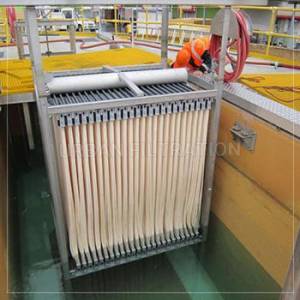Description
Biological Wastewater Treatment: MBR, MBBR, SBR, and ASP Systems
This document details four leading biological wastewater treatment technologies: Membrane Bioreactor (MBR), Moving Bed Biofilm Reactor (MBBR), Sequencing Batch Reactor (SBR), and Anaerobic Sequencing Batch Reactor (ASP). Each offers unique advantages and is suitable for different applications based on effluent quality requirements, space constraints, and operational preferences.
1. Membrane Bioreactor (MBR)
Description: MBR combines conventional activated sludge treatment with membrane filtration. The membrane acts as a final filtration stage, removing suspended solids and significantly improving effluent quality. This results in exceptionally clear, high-quality treated water.
Advantages:
- Superior effluent quality: Produces consistently high-quality effluent, exceeding conventional treatment standards. Excellent removal of suspended solids, turbidity, and pathogens.
- Small footprint: Significantly smaller footprint compared to conventional systems due to higher biomass concentration. Ideal for space-constrained applications.
- Reduced sludge production: Lower sludge production due to higher biomass concentration and efficient solids removal.
- Improved effluent stability: Consistent effluent quality regardless of influent variations.
Disadvantages:
- Higher capital costs: Initial investment is higher than other biological treatment methods due to membrane installation and maintenance.
- Membrane fouling: Membranes are prone to fouling, requiring regular cleaning and replacement, which contributes to operational costs.
- Energy consumption: Membrane operation requires energy, contributing to overall operating costs.
2. Moving Bed Biofilm Reactor (MBBR)
Description: MBBR utilizes suspended biofilm carriers within an aeration basin. Microorganisms colonize the surface of these carriers, providing a large surface area for biological treatment. The carriers move freely within the basin, ensuring good mixing and efficient oxygen transfer.
Advantages:
- High treatment capacity: High biomass concentration and efficient oxygen transfer result in high treatment capacity per unit volume.
- Robust and stable performance: Less sensitive to influent variations compared to activated sludge systems.
- Reduced sludge production: Lower sludge production compared to conventional activated sludge systems.
- Relatively low energy consumption: Requires less energy for aeration compared to activated sludge.
Disadvantages:
- Carrier degradation: Biofilm carriers can degrade over time, requiring replacement.
- Potential for carrier clogging: Over time, carriers can become clogged with biomass, reducing efficiency.
- Limited solids removal: While effective for BOD and COD removal, it may require additional clarification stages for suspended solids removal.
3. Sequencing Batch Reactor (SBR)
Description: SBR is a batch process where wastewater is treated in a single tank through a series of fill, react, settle, and draw phases. The process cycles continuously, offering flexibility and control.
Advantages:
- Simple operation and control: Relatively simple to operate and control.
- Flexibility in operation: Can handle variable influent flows and loads.
- High biomass concentration: High biomass concentration results in efficient treatment.
- Suitable for small-scale applications: Effective for small-scale wastewater treatment plants.
Disadvantages:
- Intermittent effluent discharge: Effluent is discharged intermittently, requiring storage or equalization.
- Requires adequate space: Requires sufficient space to accommodate the fill and settle phases.
- Higher operating costs: More complex automation and control systems can increase operating costs.
4. Anaerobic Sequencing Batch Reactor (ASP)
Description: ASP is a modified SBR process that utilizes anaerobic conditions for the initial phase of treatment. This allows for the breakdown of organic matter without the need for oxygen, reducing energy consumption and producing biogas as a byproduct.
Advantages:
- Energy savings: Anaerobic digestion reduces energy consumption compared to aerobic processes.
- Biogas production: Produces biogas, a renewable energy source.
- Reduced sludge production: Significantly reduces sludge production compared to aerobic processes.
- Effective for high-strength wastewater: Well-suited for treating wastewater with high organic loads.
Disadvantages:
- Longer treatment times: Anaerobic digestion is a slower process than aerobic treatment.
- Sensitive to influent variations: Performance can be affected by significant variations in influent composition.
- Requires specialized expertise: Operation and maintenance require specialized expertise in anaerobic treatment.
Conclusion:
The choice of wastewater treatment technology depends on several factors including effluent quality requirements, budget constraints, available space, and operational expertise. This overview provides a comprehensive comparison of MBR, MBBR, SBR, and ASP systems, enabling informed decision-making for various wastewater treatment applications. Further consultation with wastewater treatment specialists is recommended to determine the most suitable solution for specific needs.
